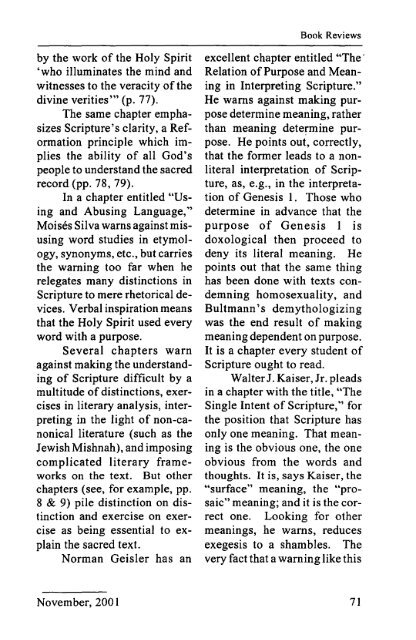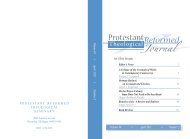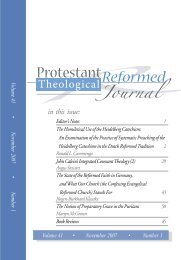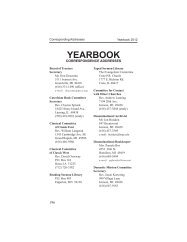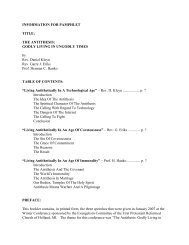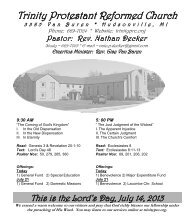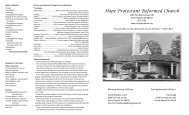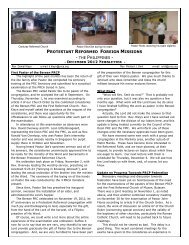pdf - Protestant Reformed Churches in America
pdf - Protestant Reformed Churches in America
pdf - Protestant Reformed Churches in America
Create successful ePaper yourself
Turn your PDF publications into a flip-book with our unique Google optimized e-Paper software.
Book Reviewsby the work of the Holy Spirit'who illum<strong>in</strong>ates the m<strong>in</strong>d andwitnesses to the veracity ofthediv<strong>in</strong>e verities'" (p. 77).The same chapter emphasizesScripture's clarity, a Reformationpr<strong>in</strong>ciple which impliesthe ability of all God'speople to understand the sacredrecord (pp. 78, 79).In a chapter entitled "Us<strong>in</strong>gand Abus<strong>in</strong>g Language,"Moises Silva warns aga<strong>in</strong>st misus<strong>in</strong>gword studies <strong>in</strong> etymology,synonyms, etc., but carriesthe warn<strong>in</strong>g too far when herelegates many dist<strong>in</strong>ctions <strong>in</strong>Scripture to mere rhetorical devices.Verbal <strong>in</strong>spiration meansthat the Holy Spirit used everyword with a purpose.Several chapters warnaga<strong>in</strong>st mak<strong>in</strong>g the understand<strong>in</strong>gof Scripture difficult by amultitude ofdist<strong>in</strong>ctions, exercises<strong>in</strong> literary analysis, <strong>in</strong>terpret<strong>in</strong>g<strong>in</strong> the light of non-canonicalliterature (such as theJewish Mishnah), and impos<strong>in</strong>gcomplicated literary frameworkson the text. But otherchapters (see, for example, pp.8 & 9) pile dist<strong>in</strong>ction on dist<strong>in</strong>ctionand exercise on exerciseas be<strong>in</strong>g essential to expla<strong>in</strong>the sacred text.Norman Geisler has anexcellent chapter entitled "The'Relation ofPurpose and Mean<strong>in</strong>g<strong>in</strong> Interpret<strong>in</strong>g Scripture."He warns aga<strong>in</strong>st mak<strong>in</strong>g purposedeterm<strong>in</strong>e mean<strong>in</strong>g, ratherthan mean<strong>in</strong>g dete~m<strong>in</strong>e purpose.He po<strong>in</strong>ts out, correctly,that the former leads to a nonliteral<strong>in</strong>terpretation of Scripture,as, e.g., <strong>in</strong> the <strong>in</strong>terpretationof Genesis 1. Those whodeterm<strong>in</strong>e <strong>in</strong> advance that thepurpose of Genesis I isdoxological then proceed todeny its literal mean<strong>in</strong>g. Hepo<strong>in</strong>ts out that the same th<strong>in</strong>ghas been done with texts condemn<strong>in</strong>ghomosexuality, andBultmann's demythologiz<strong>in</strong>gwas the end result of mak<strong>in</strong>gmean<strong>in</strong>g dependent on purpose.It is a chapter every student ofScripture ought to read.WalterJ. Kaiser, Jr. pleads<strong>in</strong> a chapter with the title, "TheS<strong>in</strong>gle Intent of Scripture," forthe position that Scripture hasonly one mean<strong>in</strong>g. That mean<strong>in</strong>gis the obvious one, the oneobvious from the words andthoughts. It is, says Kaiser, the"surface" mean<strong>in</strong>g, the "prosaic"mean<strong>in</strong>g; and it is the correctone. Look<strong>in</strong>g for othermean<strong>in</strong>gs, he warns, reducesexegesis to a shambles. Thevery fact that a warn<strong>in</strong>g like thisNovember, 200 I71


